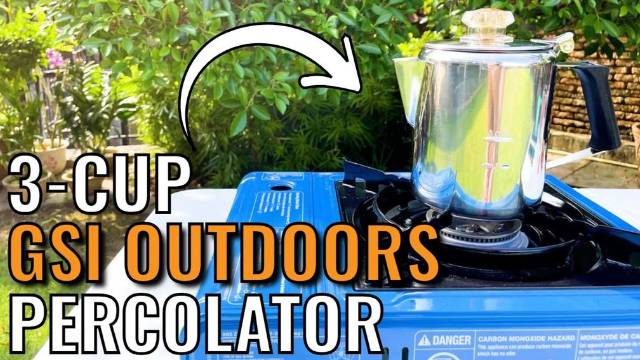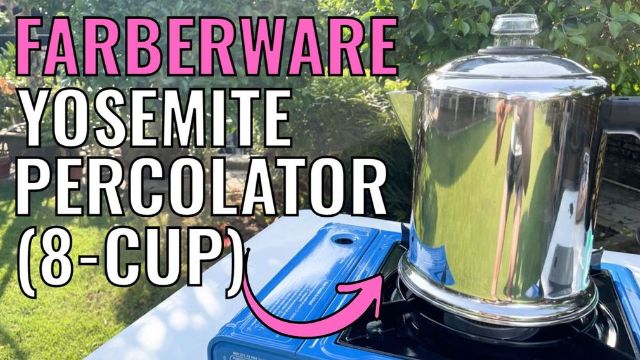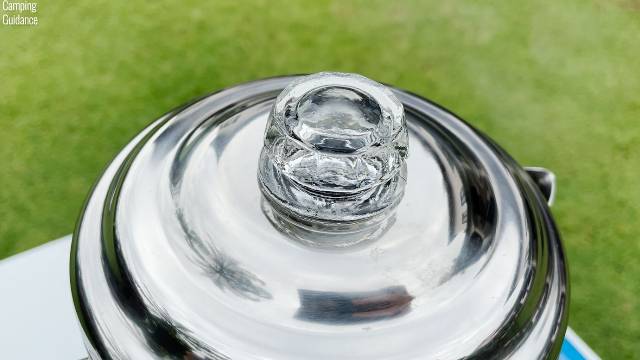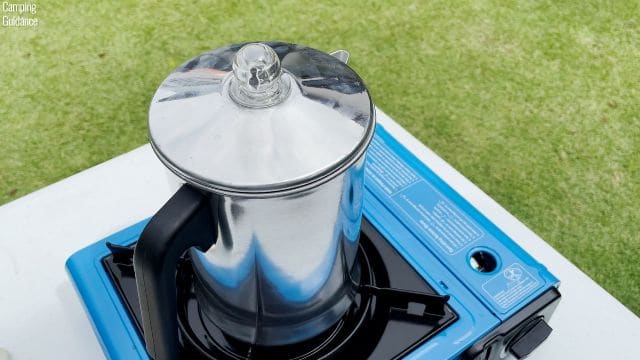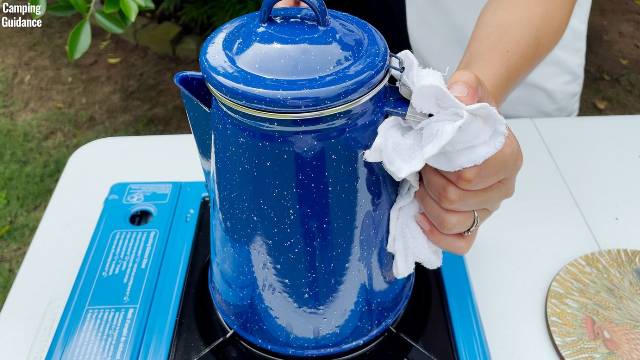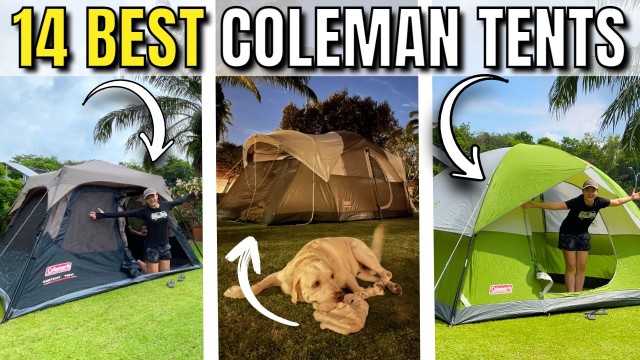The 9 Best Camping Percolators (2025): I Bought & Tested Them All
This page contains affiliate links, and that means that I may earn a commission if you buy something, at no extra cost to you. You can find my full disclosure policy here.
For this review, I bought and tested these 9 best camping percolators:
- Coleman Stainless Steel Percolator (12-Cup);
- Coletti Bozeman Camping Percolator (9-Cup);
- Stanley Camp Percolator (6-Cup);
- GSI Outdoors Glacier Stainless Steel Percolator (3-Cup);
- Farberware Classic Yosemite Percolator (8-Cup);
- Primula Today Aluminum Percolator (9-Cup);
- GSI Outdoors Enamelware Percolator (8-Cup);
- Stansport Enamel Percolator (8-Cup); and
- Bialetti Moka Express (6-Cup).
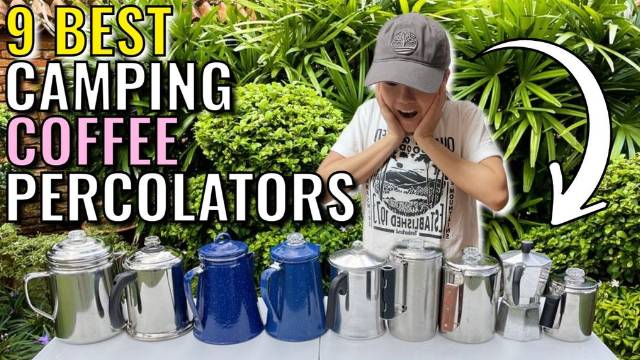
Summary
Here are all the camping percolators that I recommend (after buying and testing, of course):
| Percolator | Recommendation | Score | Price |
|---|---|---|---|
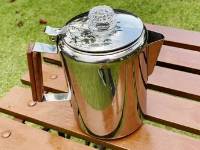 |
BEST OVERALL Coletti Bozeman Percolator
|
||
 |
RUNNER UP GSI Outdoors Glacier Percolator
|
||
 |
MOST PORTABLE GSI Outdoors Glacier Percolator
|
||
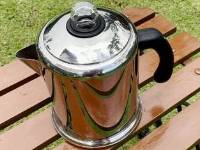 |
BUDGET PICK Farberware Yosemite Percolator
|
||
 |
EASIEST TO USE Bialetti Moka Express
|
If you enjoyed the video, please consider subscribing to my YouTube channel right here:
All the camping percolators that I bought and tested:
| Camping Percolator | Read Review | Check Price |
|---|---|---|
| Coletti | Full Review | Amazon |
| GSI Glacier | Full Review | Amazon, REI Co-Op, Backcountry |
| Farberware | Full Review | Amazon |
| Stanley | Full Review | Amazon |
| Coleman | Full Review | Amazon |
| Bialetti | Full Review | Amazon |
| Primula | Full Review | Amazon |
| GSI Enamel | Full Review | Amazon |
| Stansport | Full Review | Amazon |
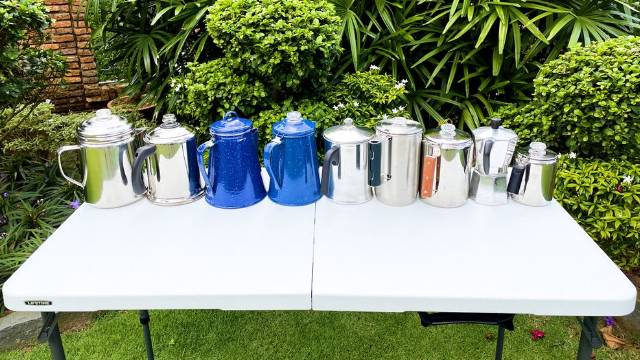
*These are my measured specifications of the 9 best camping percolators, and may differ from the brand’s marketed specifications.
| Percolator | Capacity | Length | Width | Height | Handle Size | Weight | Made in? |
|---|---|---|---|---|---|---|---|
| Coletti Bozeman Percolator | 9-cup | 8 in | 5 in | 8 in | 4 in | 26.1 oz | China |
| GSI Outdoors Glacier Percolator | 3-cup | 7.5 in | 4 in | 6 in | 2.5 in | 14.8 oz | China |
| Farberware Yosemite Percolator | 8-cup | 9 in | 6.25 in | 8.5 in | 4.5 in | 27.4 oz | China |
| Stanley Camp Percolator | 6-cup | 8 in | 4.5 in | 8.5 in | 4.25 in | 19.8 oz | China |
| Coleman Percolator | 12-cup | 9 in | 6.5 in | 9.5 in | 4.25 in | 36.2 oz | China |
| Bialetti Moka Express | 6-cup | 7 in | 4 in | 8.25 in | 3.5 in | 20.4 oz | Italy |
| Primula Aluminum Percolator | 9-cup | 8 in | 5 in | 8 in | 4.25 in | 11.6 oz | China |
| GSI Outdoors Enamelware Percolator | 8-cup | 8 in | 6 in | 9 in | 5.25 in | 20.7 oz | Mexico |
| Stansport Enamel Percolator | 8-cup | 7.5 in | 6.5 in | 9.5 in | 5.5 in | 21.3 oz | China |
For more clarification:
- Length: The longest measurement from the handle to spout.
- Width: The diameter of the widest part of the coffee pot.
- Height: The longest distance from the base to the perking knob.
- Handle size: The longest vertical length from one end of the handle to the other.
And here’s the anatomy of each camping coffee percolator, and also some terminology that I will be using throughout this entire review.

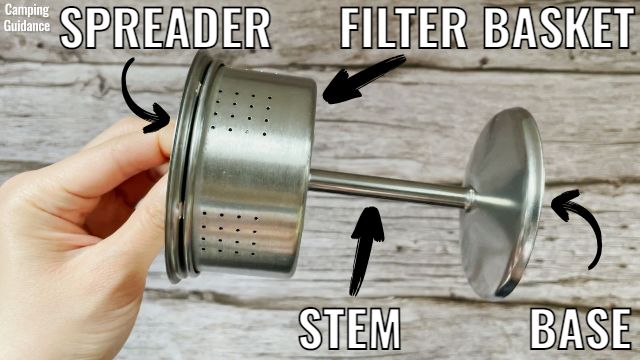
For the materials used in the construction of each camping percolator, here are all the details:
| Percolator | Pot Material | Inner Material | Knob Material | Handle Material |
|---|---|---|---|---|
| Coletti Bozeman Percolator | Stainless Steel (18/8) | Stainless Steel (18/8) | Glass | Rosewood |
| GSI Outdoors Glacier Percolator | Stainless Steel (18/8) | Stainless Steel (18/8) | Resin (Plastic) | Silicone |
| Farberware Yosemite Percolator | Stainless Steel | Stainless Steel | Glass | Plastic |
| Stanley Camp Percolator | Stainless Steel (18/8) | Stainless Steel (18/8) | Plastic | Silicone (Removable) |
| Coleman Percolator | Stainless Steel | Stainless Steel | Glass | Stainless Steel |
| Bialetti Moka Express | Cast Aluminum | N.A. | N.A. | Plastic |
| Primula Aluminum Percolator | Aluminum | Aluminum | Plastic | Plastic |
| GSI Outdoors Enamelware Percolator | Steel with enamel finish | Aluminum | Resin (Plastic) | Steel with enamel finish |
| Stansport Enamel Percolator | Metal with enamel finish | Aluminum | N.A. | Metal with enamel finish |
For more clarification:
- Pot material: Material of the outer coffee pot.
- Inner material: Material of the inner percolator.
- Knob material: Material of the perk knob.
In case you’re wondering what’s the difference between the outer coffee pot and the inner percolator, here’s a picture showing you what you’ll find when you open up the lid of a camping percolator:

I spent almost $300 buying, and 4 months testing and reviewing these 9 camping percolators.
Over 4 months, I brewed coffee in at least 1 of these camping percolators every day. (Everyone needs their morning coffee, right?) To thoroughly test all of them, I brewed coffee both outdoors and indoors, on portable stoves and home stoves, brewed 1 cup at a time to 12 cups at a time (subject to the maximum capacity of each percolator), amongst other things.
After all that, here’s how I scored each of the 9 camping percolators (10 is the best, 1 is the worst).
| Camping Percolator | Overall Rating |
|---|---|
| Coletti Bozeman Percolator | 8.9 |
| GSI Outdoors Glacier Percolator | 8.6 |
| Farberware Yosemite Percolator | 8.4 |
| Stanley Camp Percolator | 8.2 |
| Coleman Percolator | 8.1 |
| Bialetti Moka Express | 7.7 |
| Primula Aluminum Percolator | 6.9 |
| GSI Outdoors Enamelware Percolator | 6.7 |
| Stansport Enamel Percolator | 5.7 |
Top Picks
Which camping percolators are in my Top Picks? (Note: I measure each cup as a 6-ounce cup.)
Best Overall: Coletti Bozeman Camping Coffee Percolator
Key Info
- I Bought the: 9-cup
- Maximum Capacity: 5 cups
- Minimum Capacity: 3 cups
- Material: 18-gauge, 18/8 stainless steel (coffee pot and inner percolator)
- Features: Markings, glass knob, rosewood handle, cover hinge
- Weight: 26.1oz / 738g
Pros and Cons
Summary
The Coletti Bozeman Camping Coffee Percolator is an incredible tank of a camping percolator. Made of 18-gauge, Type 18/8, food-safe stainless steel, a thick 3mm glass knob, and a solid rosewood handle, my Coletti Percolator has withstood weeks of use with hardly any signs of wear. The quality of the materials used outshines that of most camping percolators on the market. It’s also complete with lots of features, excellent packaging, instructions and even coffee filter paper.

However, I found that the 9-cup capacity marketed by Coletti is pretty much overstated. I could brew a maximum of only 5 cups with 53 grams of coffee grounds. (6 cups with 64 grams of grounds will have the filter basket overflowing.)
The Coletti Bozeman Percolator is the highest quality pick if you prefer a stainless steel percolator with a glass knob and wood handle. Just be mindful of the overstated capacity.
More info on the Coletti Percolator:
Runner Up + Most Portable: GSI Outdoors Glacier Coffee Percolator
Key Info
- I Bought the: 3-cup
- Maximum Capacity: 3 cups (if 1 cup is 5 oz)
- Minimum Capacity: 2 cups (if 1 cup is 5 oz)
- Material: 18/8, marine-grade stainless steel (coffee pot and inner percolator)
- Features: Markings, resin PercView knob, silicone handle, cover hinge
- Weight: 14.8oz / 418g
Pros and Cons
Summary
The GSI Outdoors Glacier Stainless Steel Coffee Percolator is another workhorse of a camping percolator. It’s made of marine-grade, heavy gauge, 18/8 stainless steel, and even the welds are marine-grade. The PercView knob is made of thick 2.3mm resin, the handle is made of silicone, and to top it all off, you get a lifetime warranty from GSI Outdoors.

Another fantastic advantage that GSI Outdoors offers is a wide range of capacity options. I bought the tiny 3-cup Glacier Percolator, which weighs just 14.8oz, and is perfect if you’re solo-camping or you don’t drink that much coffee. However, the handle on the 3-cup is a little small, coming in at just 2.5 inches.
The Coletti Bozeman and GSI Outdoors Glacier Percolators have very similar design and features, but the GSI Glacier Percolator might actually be a better fit for you if you prefer a resin to glass perk knob (although you can buy a glass knob from GSI), a silicone to rosewood handle, a lifetime warranty, and a 3-cup capacity for additional portability.
More info on the GSI Glacier Percolator:
Best Budget Pick: Farberware Classic Yosemite Coffee Percolator
Key Info
- I Bought the: 8-cup
- Maximum Capacity: 8 cups
- Minimum Capacity: 3-4 cups
- Material: Stainless steel (coffee pot and inner percolator)
- Features: Markings, glass knob, plastic handle, tight-fitting lid and basket
- Weight: 27.4oz / 777g
Pros and Cons
Summary
The Farberware Classic Yosemite Coffee Percolator was an extremely pleasant surprise. Even though it’s my least expensive stainless steel percolator (and was even cheaper than most of my enamel and aluminum percolators), it boasts loads of features, has a surprisingly versatile range of number of cups of coffee I could brew, and the stainless steel coffee pot and inner percolator are of good quality.
However, the plastic handle isn’t the most heat-resistant, and gets hot when using higher heat. Also, the glass knob is fairly thin, coming in at just 1.8mm. But hey, for the price, who’s complaining, right? (I paid US$18 for mine.)
The Farberware Yosemite Percolator is perfect if you’re new to coffee percolators and are just trying them out for the first time, or you’re on a tight budget. But bear in mind that prices on Amazon can fluctuate, so if the Farberware Percolator gets really expensive, I think you’ll be better off with the higher quality Coletti Bozeman Percolator or the GSI Outdoors Glacier Percolator above.
More info on the Farberware Percolator:
Easiest to Use: Bialetti Moka Express
Key Info
- I Bought the: 6-cup
- Maximum Capacity: 6 cups
- Minimum Capacity: 6 cups
- Material: Aluminum
- Features: Markings, ergonomic and heat-resistant plastic handle
- Weight: 20.4oz / 577g
Pros and Cons
Summary
The Bialetti Moka Express, in terms of ease of use, beats your traditional percolator hands down. There’s no need to measure amount of water, amount of coffee, and no need to watch the perk knob for a specific timing. The brew time is about half the time of traditional percolators, there are no grounds in the coffee, and the clean up is super easy with just warm water, and it leaves no trace of oily residue, unlike the other percolators.
However, there’s no versatility with the number of cups of coffee, even on days that you want to drink less. My 6-cup Bialetti Moka Express means 6 cups of concentrated coffee, no more and no less. Also, it’s not dishwasher-safe.
The Bialetti Moka Express is great if you don’t want the hassle of measuring water and coffee, timing your brew, and filtering out grounds from the last cup of coffee.
More info on the Bialetti:
The Other Percolators I Tested
These are the camping percolators that I tested. Not as impressive as my Top Picks, but some are still pretty great.
Stanley Camp Percolator
Key Info
- I Bought the: 6-cup
- Maximum Capacity: 6 cups
- Minimum Capacity: 3 cups
- Material: 18/8 stainless steel (coffee pot and inner percolator)
- Features: Removable silicone grip, markings, plastic perk knob
- Weight: 19.8oz / 560g
Pros and Cons
Summary
For die-hard Stanley fans, this Stanley Camp Percolator is yet another quality product from Stanley with good quality, food-grade stainless steel, a genius removable grip that provides lots of versatility (for cooking over an open flame if you need to), flexibility as to the number of cups of coffee you can brew (between 3-6 cups), and of course, a lifetime warranty from Stanley.

However, there seems to be this issue of customers not receiving missing parts. For me, I was missing the spreader. Also, the base is narrow, so the brew time is longer, it’s top heavy, and the Stanley is also my least stable camping percolator. And it’s really quite expensive.
If you’re loyal to the Stanley brand, I still think the Stanley Camp Percolator is a good quality product, but it’s just not the best camping percolator on the market.
More info on the Stanley Percolator:
Coleman Stainless Steel Percolator
Key Info
- I Bought the: 12-cup
- Maximum Capacity: 9-10 cups
- Minimum Capacity: 6 cups
- Material: Stainless steel (coffee pot and inner percolator)
- Features: Glass perk knob, tight-fitting lid
- Weight: 36.2oz / 1,025g
Pros and Cons
Summary
The Coleman Stainless Steel Coffee Percolator is another heavy-gauge, quality stainless steel percolator, complete with an extremely thick 3.5mm glass knob, the thickest of the lot.
But it’s not exactly a 12-cup, it’s more like a 9 or 10-cup capacity. It also doesn’t have water-level markings, the handle is not comfortable, the handle also gets hot, there’s no lifetime warranty, and no replacement glass knobs.
The Coleman Percolator is not a bad percolator, but it’s just not a great one. It does have its pros, but also plenty of cons.
More info on the Coleman Percolator:
Primula Today Aluminum Percolator
Key Info
- I Bought the: 9-cup
- Maximum Capacity: 6 cups
- Minimum Capacity: 4 cups
- Material: Aluminum (coffee pot and inner percolator)
- Features: Plastic perk knob, fitted lid, plastic handle
- Weight: 11.6oz / 330g
Pros and Cons
Summary
The Primula Today Aluminum Percolator is a lightweight and highly inexpensive camping percolator.
Unfortunately, you get what you pay for with the Primula Aluminum Percolator. The capacity is overstated, and it’s not very user-friendly, with the lack of water level markings and the handle that’s not the most heat-resistant.
The biggest disadvantage is the quality issues; there’s a lot of staining after some light usage, the stem is very bent, the entire percolator feels very flimsy, and the plastic knob is very thin. Overall, quality is just lacking.
This Primula Aluminum Percolator may be highly inexpensive, but I find it difficult to recommend this because of the quality issues. I paid almost the same price for the Farberware Yosemite Percolator, which is much higher quality, and will give you much better value for money. (But do check Amazon for the latest prices in case they’ve changed.)
More info on the Primula Percolator:
Stansport Enamel Percolator
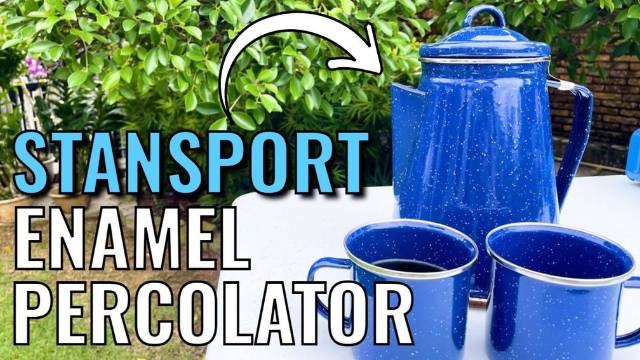
Key Info
- I Bought the: 8-cup
- Maximum Capacity: 5 cups
- Minimum Capacity: 5 cups
- Material: Metal with enamel finish (coffee pot) and aluminum (inner percolator)
- Features: None
- Weight: 21.3oz / 604g
Pros and Cons
Summary
The Stansport Enamel Percolator comes with 4 matching enamel mugs, which is nice to have. Of course, it looks great too, and really brings back those days of nostalgia.
But personally, I’m not a big fan of this because the capacity is way overstated. It’s also just not user-friendly enough, with the lack of a heat-resistant handle, water level markings, and even a perk knob! There’s also no flexibility with the capacity. I could percolate only 5 cups of coffee. Any more would boil over and I would have grounds in my coffee, and any less will taste diluted. This is just too limited.
Overall, the Stansport Enamel Percolator isn’t user-friendly enough for me to recommend it as the best camping percolator.
More info on the Stansport Percolator:
GSI Outdoors Enamelware Percolator
Key Info
- I Bought the: 8-cup
- Maximum Capacity: 5 cups
- Minimum Capacity: 4 cups
- Material: Steel with enamel finish (coffee pot) and aluminum (inner percolator)
- Features: Resin PercView knob
- Weight: 20.7oz / 587g
Pros and Cons
Key Info
The GSI Outdoors Enamelware Percolator comes with a lifetime warranty, and of course, looks great and nostalgic.
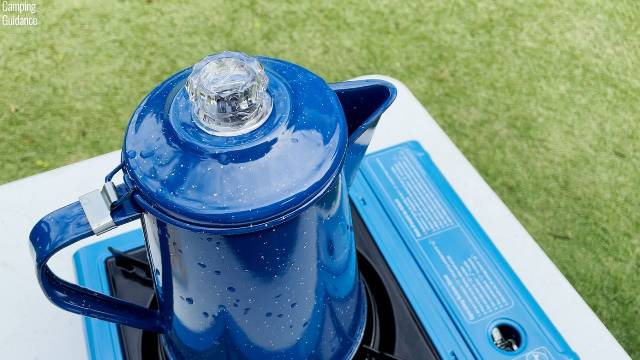
But out of all my camping percolators, this GSI Outdoors Enamelware Percolator was the most disappointing, especially in terms of quality.
The capacity is way overstated, it doesn’t have features other than the resin PercView knob, I could brew only 4 or 5 cups of coffee, no more and no less, rust started forming around the rim of the lid after some light usage, and there was chipping out of the box.
More info on the GSI Enamelware Percolator:
Recommendation Summary
Here’s a summary of all the camping percolators that I bought and tested:
Top Picks:
- Coletti Bozeman Percolator: Best Overall
- GSI Outdoors Glacier Percolator: Runner Up + Most Portable
- Farberware Classic Yosemite Percolator: Best Budget Pick
- Bialetti Moka Express: Easiest to Use
The Others:
- Stanley Camp Percolator: A good quality percolator if you’re a Stanley fan.
- Coleman Stainless Steel Percolator: Good quality, but not user-friendly, and no replacements if the glass knob breaks.
- Primula Aluminum Percolator: Inexpensive, but quality isn’t good. Would not recommend.
- Stansport Enamel Percolator: Not user-friendly at all, with slight quality issues. Would not recommend.
- GSI Outdoors Enamelware Percolator: The lowest quality percolator I bought. Would not recommend.
If you’d like to compare how each of the 9 best camping percolators performed in each test, here’s a cool graphic where you can do so:

For more information on how I tested each camping percolator and came up with these scores, I’ll explain all of it in detail in the next section.
Performance and Test Results
I put each camping percolator through these 7 different tests:
- Brew Time
- Capacity
- Ease of Use
- Ease of Clean Up
- Portability
- Quality
- Taste
At the end of all the tests, I compiled all the data and came to a decision in the Overall Performance section.
How I Tested
All the 9 best camping percolators in this review are stove-top percolators, so I tested them on my stove at home, and also on a Coleman Portable Butane Stove.
To get a coarse grind, I used a Hario Mini Mill Hand Grinder.
I used whole bean, medium roast coffee from Lavazza.
For measuring water, 6 ounces for 1 cup, I used a Pyrex measuring cup. And lastly, for measuring the weight of my coarse ground coffee, I used a Etekcity Digital Kitchen Scale from Amazon.

Brew Time
For brew time, I looked at:
- The time to first perk; and
- The time of complete brew.
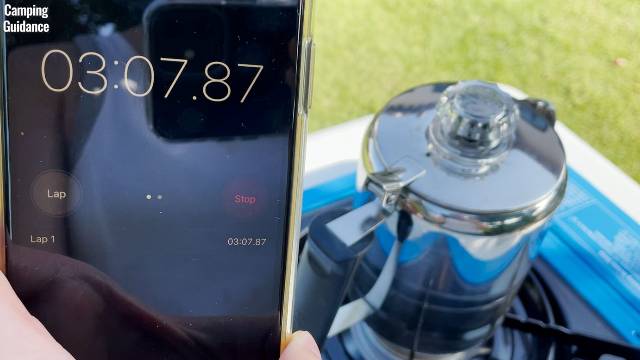
Time to First Perk (3-Cup)
The time to first perk is the amount of time it takes for the water to start boiling, or for percolation to start.
Using medium heat to bring the water to a boil, I compared the timings of all the camping percolators in a 3-cup (or 18-ounce) capacity, and here are the timings from fastest to slowest:
| Percolator | Cups | Ounces | First Perk |
|---|---|---|---|
| Stansport | 3 | 18 | 4 mins 30 secs |
| GSI Enamel | 3 | 18 | 4 mins 45 secs |
| Primula | 3 | 18 | 4 mins 45 secs |
| Coletti | 3 | 18 | 4 mins 45 secs |
| Farberware | 3 | 18 | 5 mins |
| GSI Glacier | 2.5 | 15 | 5 mins 30 secs |
| Coleman | 3 | 18 | 6 mins |
| Stanley | 3 | 18 | 7 mins 45 secs |
| Bialetti | N.A. | N.A. | N.A. |
My stainless-steel percolators took a slightly longer time to start percolating coffee as compared to my enamel and aluminum percolators, but overall, most of my percolators took between 4 to 6 minutes for the water to boil in a 3-cup or 18-ounce capacity.
The Stanley Camp Percolator took quite a bit longer than the rest, I think because the base is narrower, so it takes a longer time for all the water to heat up.
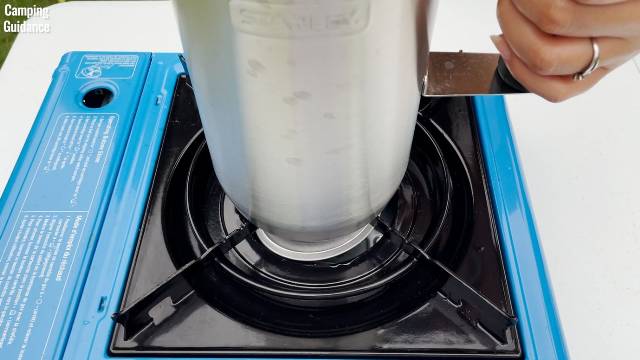
Time to First Perk (6-Cup)
As for a 6-cup (or 36-ounce) capacity, here are all the timings:
| Percolator | Cups | Ounces | First Perk |
|---|---|---|---|
| Bialetti | 6 | 11 | 5 mins 15 secs |
| Coleman | 6 | 36 | 6 mins 45 secs |
| GSI Enamel | 6 | 36 | 8 mins |
| Stansport | 6 | 36 | 8 mins 15 secs |
| Farberware | 6 | 36 | 8 mins 30 secs |
| Primula | 6 | 36 | 8 mins 45 secs |
| Coletti | 6 | 36 | 10 mins |
| Stanley | 6 | 36 | 10 mins |
| GSI Glacier | N.A. | N.A. | N.A. |
For the Bialetti Moka Express, I measured the time it took for coffee to start oozing into the collector.
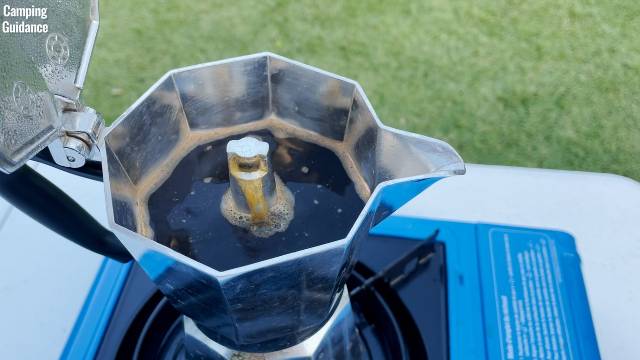
Most of my percolators took between 8 to 10 minutes for the water to boil in a 6-cup or 36-ounce capacity, and stainless steel is generally a bit slower than enamel and aluminum.
These are all estimates and can vary by up to 1, maybe even 2 minutes, depending on lots of factors like surrounding temperature.
Time of Complete Brew (6-Cup)
For the time it takes to make a complete brew, for all the percolators except for the Bialetti, I usually let the coffee percolate for about 7 minutes on medium-low heat.
So, this adds an additional 7 minutes to the time to first perk, so at a 6-cup capacity, my percolators took between 14 to 17 minutes for the complete brew.
| Percolator | First Perk | Complete Brew |
|---|---|---|
| Bialetti Moka Express | N.A. | 8 mins 15 secs |
| Coleman Percolator | 6 mins 45 secs | 13 mins 45 secs |
| GSI Outdoors Enamelware Percolator | 8 mins | 15 mins |
| Stansport Enamel Percolator | 8 mins 15 secs | 15 mins 15 secs |
| Farberware Yosemite Percolator | 8 mins 30 secs | 15 mins 30 secs |
| Primula Aluminum Percolator | 8 mins 45 secs | 15 mins 45 secs |
| Coletti Bozeman Percolator | 10 mins | 17 mins |
| Stanley Camp Percolator | 10 mins | 17 mins |
The Bialetti Moka Express was much faster, and the entire brew was complete in about 8 minutes and 15 seconds, which is about half the time.
Brew Time Ratings
Based on the time to first perk and time of complete brew, I rated each camping percolator’s brew times (out of 10, with 10 being the fastest brew time).
Here are the ratings in chart form:
And also in table form:
| Percolator | Brew Time Rating |
|---|---|
| Bialetti Moka Express | 10.0 |
| Stansport Enamel Percolator | 7.5 |
| GSI Outdoors Enamelware Percolator | 7.5 |
| Primula Aluminum Percolator | 7.5 |
| Coleman Percolator | 7.5 |
| Farberware Yosemite Percolator | 7.0 |
| Coletti Bozeman Percolator | 7.0 |
| GSI Outdoors Glacier Percolator | 7.0 |
| Stanley Camp Percolator | 6.0 |
The Bialetti Moka Express was the fastest, and the Stanley Camp Percolator was the slowest because of the narrow base. Stainless steel is generally a bit slower than enamel and aluminum.
Capacity
The capacity marketed by each brand is often not the most accurate, at least from my own testing.
Maximum Capacity (in Cups)
Here’s each brand’s marketed maximum capacity starting from the smallest (middle column), and my tested maximum capacity of each percolator (right column), both in cups:
| Percolator | Brand | My Testing |
|---|---|---|
| GSI Outdoors Glacier | 3 | 2.5 |
| Bialetti Moka Express | 6 | 5.5 |
| Stanley Camp Percolator | 6 | 6 |
| GSI Enamel Percolator | 8 | 5 |
| Stansport Percolator | 8 | 5 |
| Farberware Percolator | 8 | 8 |
| Primula Percolator | 9 | 6 |
| Coletti Bozeman | 9 | 5 |
| Coleman Percolator | 12 | 9 |
The Bialetti is based on 2-ounce cups of concentrated coffee, and the rest are based on 6-ounce cups of regular coffee.
How did I test for the maximum capacity?
For some percolators (like the Farberware Yosemite and the GSI Outdoors Glacier Percolators), I could fill them with water all the way to the bottom of the holes of the spout without them boiling over, and if so, I took this to be the maximum capacity.
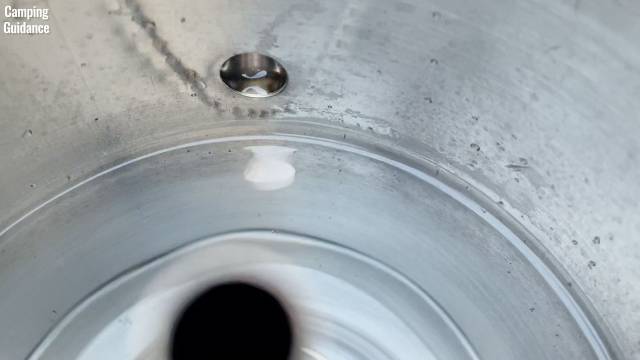
For other percolators though (like the Stansport and GSI Outdoors Enamel Percolators), they boiled over even when the water level was way below the holes of the spout.

Filter Basket Maximum Capacity
I also looked at the maximum capacity of each percolator’s filter basket when packed to the brim:
| Filter Basket | Grams | Ounces |
|---|---|---|
| GSI Outdoors Glacier | 48g | 1.7oz |
| Coletti Bozeman | 63g | 2.2oz |
| Stansport Percolator | 71g | 2.5oz |
| Stanley Camp Percolator | 80g | 2.8oz |
| GSI Enamel Percolator | 82g | 2.9oz |
| Farberware Yosemite | 93g | 3.3oz |
| Coleman Percolator | 111g | 3.9oz |
| Primula Percolator | 120g | 4.2oz |
Personally, I would not recommend packing the filter basket to the brim, because when water spreads over the grounds, the filter basket might overflow, and grounds will get into the coffee. This happened for a few of my percolators, like the Coletti, Stansport, and Coleman, so I had to reduce the maximum capacity for those.

I typically use about 10 or 11 grams of grounds for 1 cup of coffee, so using this measurement, I made sure that the filter basket did not overflow at my tested maximum capacity. So, the maximum capacity stated above is without any boiling over and without the filter basket overflowing.

Only the Stanley Camp and the Farberware Percolators are accurate, some were just slightly overstated, and some were way off base.
The maximum capacity here is based on the number of cups of water that I filled each percolator with, before brewing the coffee. After brewing, you might get 1, maybe even 2, cups of coffee less, because of the steam that escapes during boiling, and if you don’t use a coarse grind, your last cup of coffee might not be super drinkable.
Minimum Capacity (in Cups)
What about the minimum percolator capacity? If you put too little water in the coffee pot, not enough water will be pushed up the stem, and you might end up getting really diluted coffee, or even just clear water with grounds.

So, I also tested the minimum capacity of each percolator:
| Percolator | Max (Cups) | Min (Cups) |
|---|---|---|
| GSI Outdoors Glacier | 2.5 | 2 |
| Bialetti Moka Express | 5.5 | 5.5 |
| Stanley Camp Percolator | 6 | 3 |
| GSI Outdoors Enamel | 5 | 4 |
| Stansport Enamel Percolator | 5 | 5 |
| Farberware Percolator | 8 | 3 |
| Primula Percolator | 6 | 4 |
| Coletti Bozeman Percolator | 5 | 3 |
| Coleman Percolator | 9 | 6 |
For me, I think that having a bigger range of capacity options is better, because on some days, I’m the only one drinking coffee, and on other days, my whole family wants coffee.
Capacity Ratings
So, based on this, here’s how I rated each camping percolator’s capacity (out of 10, with 10 being the best, meaning that you get plenty of flexibility on the number of cups of coffee you can brew):
| Percolator | Capacity Rating |
|---|---|
| Farberware Yosemite Percolator | 10.0 |
| Stanley Camp Percolator | 10.0 |
| Coletti Bozeman Percolator | 9.0 |
| Primula Percolator | 8.0 |
| Coleman Percolator | 8.0 |
| GSI Outdoors Glacier Percolator | 8.0 |
| GSI Outdoors Enamel Percolator | 7.0 |
| Stansport Enamel Percolator | 5.0 |
| Bialetti Moka Express | 5.0 |
The Stansport Enamel Percolator could take only 5 cups of water. Any more would boil over and I would have grounds in my coffee, and any less will taste diluted.
Also, the capacity of the Bialetti Moka Express can’t be altered or the coffee could get over-extracted. I scored these 2 the worst, and the rest did okay.
Ease of Use
For ease of use, I looked out for:
- Cup or water level markings;
- A perk knob or globe;
- A heat-resistant handle;
- The lid/cover;
- Stability; and
- Whether there are grounds in the coffee.
Cup or Water Level Markings
For the cup or water level markings, I looked at how easily it is to see these markings, and if there were no markings, whether I could use the holes of the spout as a rough gauge for water level.
| Percolator | Markings |
|---|---|
| Stanley Camp Percolator | Yes |
| Bialetti Moka Express | Yes |
| GSI Outdoors Glacier Percolator | Yes |
| Coletti Bozeman Percolator | Yes |
| Farberware Percolator | Yes |
| Coleman Percolator | No |
| Primula Percolator | No |
| Stansport Enamel Percolator | No |
| GSI Outdoors Enamel Percolator | No |
The Stanley Camp Percolator has these 2 bumps or protrusions on both the inside and outside of the coffee pot, which are really easy to see. Same goes for the Bialetti Moka Express, with protruding markings showing you the maximum water level below the safety valve.

The GSI Outdoors Glacier Stainless Steel Percolator also has protrusion markings on the inside and outside of the pot, but these are slightly less easy to see.
The Coletti Bozeman Percolator has cup markings on the inside and outside as well, but these are inked onto the surface. It’s a little bit harder to see. The Farberware Percolator also has inked markings, but the markings are right behind the handle, which is a bit of a weird placement.

The Coleman and Primula Percolators did not come with cup markings. The Stansport and GSI Outdoors Enamel Percolators were the worst, because I could not even use the holes of the spout as a gauge, because even though I filled them with water way below the spout, they still boiled over.
Perk Knob
Most camping percolators would come with perk knobs or globes so you can tell when the water starts boiling, and you can also see the color of your coffee.
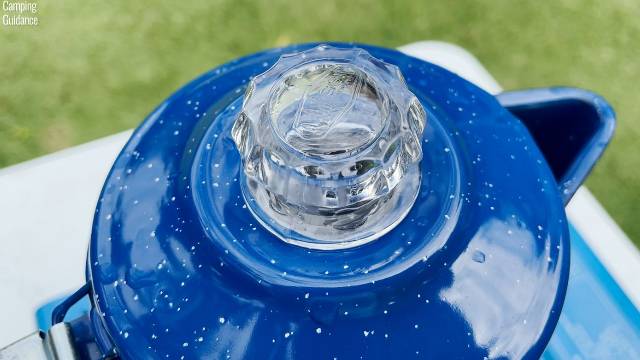
All my camping percolators had these perk knobs, except for the Stansport Enamel Percolator, which came with this small, rounded handle instead.

Heat-Resistant Handle
Another important aspect of stovetop camping percolators is having a handle that’s heat resistant and comfortable.
| Percolator | Handle Material | Cool? |
|---|---|---|
| Stanley Camp Percolator | Silicone | Yes |
| Coletti Bozeman | Rosewood | Yes |
| Bialetti Moka Express | Plastic | Yes |
| GSI Outdoors Glacier | Silicone | Yes |
| Farberware Yosemite | Plastic | Half |
| Primula Percolator | Plastic | Half |
| Stansport Enamel | Enamel | No |
| GSI Enamel Percolator | Enamel | No |
| Coleman Percolator | Steel | No |
My favorite handle has got to be this removable silicone grip on the Stanley Camp Percolator. It’s very generously sized, and you can use the Stanley over an open flame.

The Coletti Bozeman’s rosewood handle comes a close second. It looks beautiful, it’s high quality, and the steel plate and the rivets on the handle did not get hot for me on a medium flame.

I found the handle on the Bialetti very ergonomic, but it’s not very big though.

The handle on the GSI Outdoors Glacier is not very big as well, and it got hot for me when I was using high heat. I think it’s because this is a smaller pot, and the handle is closer to the fire.

The Farberware and Primula Percolators have plastic handles, which tend to get hot nearer the pot, but I felt that the Primula got hotter than the Farberware.

The Stansport, GSI Outdoors Enamel and Coleman Percolators all have the same type of handles where the middle is like sunken in, which makes it really uncomfortable to hold. Of the three, I think the Coleman Percolator is the most uncomfortable, because it’s the heaviest.

Cover or Lid
I also looked at the lid, and whether I needed potholders to hold the lid down while pouring.
| Percolator | Cover/Lid |
|---|---|
| Coleman Percolator | Tight Fitting |
| Farberware Yosemite | Tight Fitting |
| Primula Percolator | Fitting |
| Bialetti Moka Express | Plastic Top |
| Coletti Bozeman | Cover Hinge |
| GSI Outdoors Glacier | Cover Hinge |
| Stanley Camp Percolator | Loose |
| Stansport Enamel Percolator | Loose |
| GSI Enamel Percolator | Loose |
The Coleman and Farberware Percolators have tight fitting lids, while the lid on the Primula was not exactly super tight, but I did not need potholders for any of them.
The Bialetti Moka Express has a loose lid, but it has this heat-resistant plastic top here that you can press down on to keep the lid closed.

The Coletti Bozeman and GSI Outdoors Glacier Percolators also have loose lids, but they come with hinges to keep the lid closed during pouring. These hinges do get a bit hot, but they also cool quickly within a few minutes as I wait for the grounds to settle at the bottom of the pot before pouring. It’s not very comfortable to apply pressure upward on this hinge, but it gets the job done and keeps the lid closed.
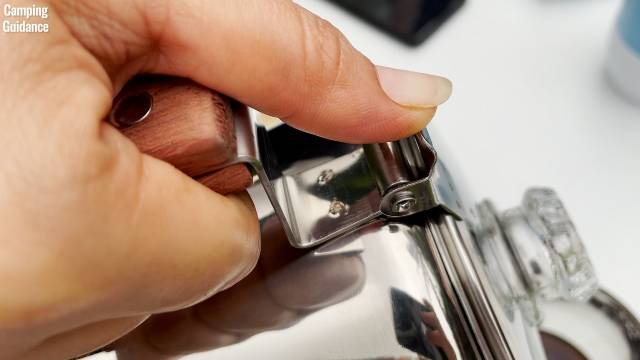
I used potholders for only the Stanley, Stansport and GSI Outdoors Enamel Percolators. There are no features to keep the lid closed while pouring out the last few drops of coffee, because that’s when the lids tend to open up.
Stability
As for stability, I looked at the diameter of the base of each percolator:
| Percolator | Base (inches) |
|---|---|
| Stansport Enamel Percolator | 6.5 |
| Coleman Percolator | 6.5 |
| Farberware Yosemite | 6.25 |
| GSI Enamel Percolator | 6 |
| Primula Percolator | 5.25 |
| Coletti Bozeman | 5 |
| GSI Outdoors Glacier | 4 |
| Bialetti Moka Express | 4 |
| Stanley Camp Percolator | 4 |
I found most of the camping percolators pretty stable, even the ones with smaller bases.
The only one that was a bit unstable was the Stanley Camp Percolator. It has a long, cylindrical design, and the diameter of the base, which is 4 inches, is smaller than the diameter of the lid, which is 4.5 inches. This makes it very top-heavy, especially when the lid is open.
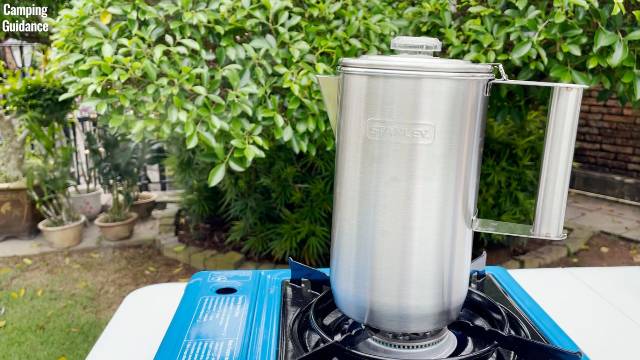
Grounds in Last Cup
And finally, I looked at whether there were any grounds in the last cup of coffee. For this test, I used a coarse coffee grind, I did not use coffee filter paper, I did not wet the filter basket, and I did not remove the inner percolator before pouring out the coffee.

Naturally, there would be some grounds in the last cup, but I found that it was minimal for all my camping percolators, as long as there was no boiling over, and the filter basket did not overflow.
| Percolator | Grounds | Filter Holes (mm) |
|---|---|---|
| Bialetti Moka Express | None | N.A. |
| Farberware Yosemite | Minimal | 1 |
| Primula Percolator | Minimal | 1 |
| Coleman Percolator | Minimal | 1 |
| GSI Outdoors Glacier | Minimal | 1 |
| Stanley Camp Percolator | Minimal | 1 |
| Stansport Enamel Percolator | Minimal | 1 |
| GSI Enamel Percolator | Minimal | 1 |
| Coletti Bozeman | Minimal | 2 |
I also measured the size of the holes in each percolator’s filter basket, and found that most of them measured about 1mm. The Coletti Bozeman Percolator had holes that are about 2mm, so slightly larger. This wasn’t a big issue for me because I used a coarse grind.
Ease of Use Ratings
Based on the water level markings, perk knob, heat-resistance of handle, cover/lid, stability and grounds in the last cup, here’s how I rated each camping percolator’s ease of use (out of 10, with 10 being the most user-friendly):
| Percolator | Ease of Use Ratings |
|---|---|
| Farberware Yosemite | 8.7 |
| Bialetti Moka Express | 8.6 |
| Coletti Bozeman | 8.5 |
| GSI Outdoors Glacier | 8.5 |
| Stanley Camp Percolator | 8.2 |
| Coleman Percolator | 7.8 |
| Primula Percolator | 7.8 |
| GSI Enamel Percolator | 6.5 |
| Stansport Enamel Percolator | 5.7 |
Ease of Clean Up
There are 2 ways that you can clean your camping percolator – by either manually cleaning it or by using a dishwasher.
Manual Cleaning
I clean all my camping percolators the same way – by first dumping the grounds, then taking apart all the componentry and running water through them.

I found all of them pretty easy to clean actually, but here are a few things to take note of.
The Bialetti Moka Express is the easiest to clean and rinse off with just warm water. There’s no leftover oily residue from the coffee bean oils, unlike the other percolators.
For my other percolators, they would feel a bit oily after rinsing off, so I would percolate water to get rid of the oil, and sometimes I use soap as well.
The Coleman and Primula Percolators are easy to clean, as everything is detachable, even the lid.
The Stansport and GSI Outdoors Enamel Percolators have this super flimsy hinge that connects the lid to the coffee pot. It’s so flimsy that I can bend it with my fingers, and remove the lid.

I found the Stanley Camp Percolator easy to clean as well, because I could remove the silicone grip, though it does have a hinged lid.
The GSI Outdoors and Coletti Bozeman Stainless Steel Percolators also have hinged lids. The Coletti Percolator also has a rosewood handle, and I noticed the wood finish dulling slightly over time, so you might want to avoid washing it too much so that it doesn’t get water damaged.
The lip of the Farberware Percolator is rolled inwards, so a bit of water will get trapped in the lip while trying to dry it. The hole of the spout is also a bit small, so it’s a little harder trying to get the last few drops of water to drain out. But it’s honestly not a big issue for me because I can just use a towel to dry it.
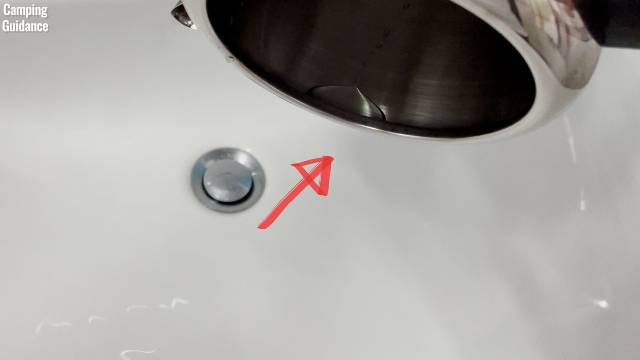
Dishwasher Cleaning
And finally, here’s the list of camping percolators that are dishwasher safe.
| Percolator | Dishwasher-Safe? | Source |
|---|---|---|
| Stanley Camp Percolator | Yes | Product Info |
| Coleman Percolator | Yes | Reviews |
| Stansport Enamel Percolator | Yes | Reviews |
| GSI Enamel Percolator | Yes | Product Info |
| GSI Outdoors Glacier | Yes | Product Info |
| Coletti Bozeman | Yes | Product Info |
| Farberware Yosemite | Yes | Product Info |
| Primula Percolator | No | Reviews |
| Bialetti Moka Express | No | Product Info |
The manual that came with the Farberware Yosemite Percolator said that it’s dishwasher-safe except for the knob and spring.
Unfortunately, I don’t have a dishwasher, so I could not test this out, but I got the information either from product info provided from the brand or from reviews from others who have bought the product.
Cleaning Ratings
Based on the above, here’s how I rated each camping percolator’s ease of clean up (out of 10, with 10 being the easiest to clean):
| Percolator | Cleaning Ratings |
|---|---|
| Coleman Percolator | 9.5 |
| Bialetti Moka Express | 9.0 |
| Stanley Camp Percolator | 9.0 |
| GSI Outdoors Glacier | 9.0 |
| Coletti Bozeman | 9.0 |
| GSI Enamel Percolator | 9.0 |
| Stansport Enamel Percolator | 9.0 |
| Farberware Yosemite | 8.5 |
| Primula Percolator | 8.5 |
Basically, they are all pretty easy to clean.
Portability
Here are the dimensions of each camping percolator that I have from smallest to largest:
| Percolator | L (in) | W (in) | H (in) |
|---|---|---|---|
| GSI Outdoors Glacier | 7.5 | 4 | 6 |
| Stanley Camp | 8 | 4.5 | 8.5 |
| Coletti Bozeman | 8 | 5 | 8 |
| Primula Percolator | 8 | 5.25 | 8 |
| GSI Enamel Percolator | 8 | 6 | 9 |
| Stansport Percolator | 7.5 | 6.5 | 9.5 |
| Farberware Yosemite | 9 | 6.25 | 8.5 |
| Bialetti Moka Express | 7 | 4 | 8.25 |
| Coleman Percolator | 9 | 6.5 | 9.5 |
And here’s the weight of each camping percolator from lightest to heaviest:
| Percolator | Weight (oz) |
|---|---|
| Primula Percolator | 11.6 |
| GSI Outdoors Glacier | 14.8 |
| Stanley Camp | 19.8 |
| Bialetti Moka Express | 20.4 |
| GSI Enamel Percolator | 20.7 |
| Stansport Percolator | 21.3 |
| Coletti Bozeman | 26.1 |
| Farberware Yosemite | 27.4 |
| Coleman Percolator | 36.2 |
If you need more details on the specs, I have more information in each individual review here:
- Coletti Bozeman Percolator Review
- GSI Outdoors Glacier Percolator Review
- Farberware Yosemite Percolator Review
- Stanley Camp Percolator Review
- Coleman Stainless Steel Percolator Review
- Bialetti Moka Express Review
- Primula Today Aluminum Percolator Review
- GSI Outdoors Enamelware Percolator Review
- Stansport Enamel Percolator Review
For a size comparison, here’s what all of them look like.

Because I bought each percolator in different capacities, I’m not going to rate them based on portability.
Quality
For quality, I looked at the:
- Material and quality of the coffee pot.
- The inner percolator.
- The perk knob.
- And the finish.
Material and Quality of Coffee Pot
Here’s the material and quality of each coffee pot, starting from the highest quality:
| Percolator | Coffee Pot Material |
|---|---|
| Coletti Bozeman | Stainless Steel |
| GSI Outdoors Glacier | Stainless Steel |
| Stanley Camp Percolator | Stainless Steel |
| Coleman Percolator | Stainless Steel |
| Farberware Yosemite | Stainless Steel |
| Bialetti Moka Express | Aluminum |
| Primula Percolator | Aluminum |
| Stansport Percolator | Enamel Finish |
| GSI Enamel Percolator | Enamel Finish |
I felt that my stainless-steel coffee pots were higher quality than my aluminum and enamel ones. Of my 5 stainless-steel coffee pots, only the Coletti, GSI Outdoors and Stanley Percolators were specifically 18/8, food-grade stainless steel. And only Coletti provided the gauge of the stainless steel, which is 18-gauge.
Since the Coletti and GSI Outdoors Stainless Steel Percolators are very similar in design, I used a pair of digital calipers to measure the thickness of the steel plates of the handles and also the spout, and I think that the Coletti Percolator is slightly heavier gauge than the GSI Outdoors Glacier.
- Coletti Bozeman (Handle Thickness): 0.05in/1.3mm
- GSI Outdoors Glacier (Handle Thickness): 0.04in/1.0mm
- Coletti Bozeman (Spout Thickness): 0.024in/0.6mm
- GSI Outdoors Glacier (Spout Thickness): 0.020in/0.5mm
Disclaimer: I could be wrong though.

The Stanley Camp Percolator is much lighter gauge than both the Coletti and GSI Outdoors Percolators, from just looking at the weight of all 3 of them. Also, I noticed a small dent in the base of my Stanley Percolator a few weeks in, even though I never dropped it or tossed it around.

I don’t know the type of stainless steel used in the Coleman and Farberware Percolators, but looking at the weight of both, I think the Coleman is heavier gauge.
I prefer stainless steel to aluminum, because 1, for health reasons, and 2, aluminum seems to wear out faster to me. The boiler of my Bialetti Moka Express looks pretty worn out, but to be fair this was after years of use. It definitely feels more sturdy and higher quality than my Primula Percolator, which started staining after just a couple of uses.

The material that I don’t like the most is the enamel finish, because of rust. My Stansport Percolator had a slight bit of rust, has a very flimsy hinge, and had coffee stains out of the box. My GSI Outdoors Enamel Percolator was lower quality, with the same flimsy hinge, heavier rusting and even chipping.
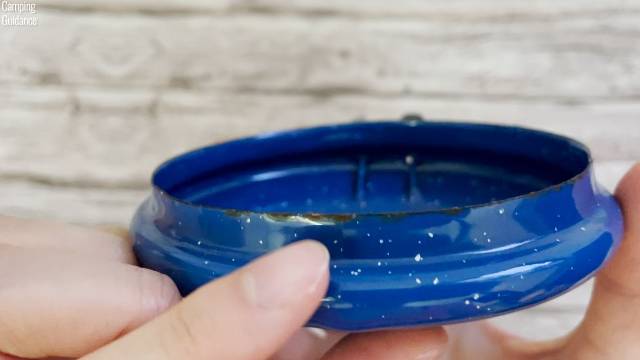
Material and Quality of Inner Percolator
Here’s the material and quality of each inner percolator:
| Percolator | Inner Material |
|---|---|
| Coletti Bozeman | Stainless Steel |
| GSI Outdoors Glacier | Stainless Steel |
| Stanley Camp | Stainless Steel |
| Coleman Percolator | Stainless Steel |
| Farberware Yosemite | Stainless Steel |
| GSI Enamel Percolator | Aluminum |
| Stansport Percolator | Aluminum |
| Primula Percolator | Aluminum |
The inner percolator is usually made of either stainless steel or aluminum. I prefer stainless steel because it’s sturdier, and none of my stainless steel percolators were bent. However, after the past few months of usage, 2 out of 3 of my aluminum inner percolators were bent, because aluminum is flimsier, bends and breaks more easily.

My Stansport Enamel Percolator had minor bending, and my Primula Today Aluminum Percolator had pretty severe bending.
Material and Thickness of Perk Knob
Here’s the material and thickness of each perk knob:
| Percolator | Material | Thickness |
|---|---|---|
| Coleman Percolator | Glass | 3.5mm / 0.14in |
| Coletti Bozeman | Glass | 3.0mm / 0.12in |
| GSI Outdoors Glacier | Resin | 2.3mm / 0.09in |
| GSI Enamel Percolator | Resin | 2.3mm / 0.09in |
| Stanley Camp Percolator | Plastic | 2.0mm / 0.08in |
| Farberware Yosemite | Glass | 1.8mm / 0.07in |
| Primula Percolator | Plastic | 0.8mm / 0.03in |
| Stansport Percolator | N.A. | N.A |
| Bialetti Moka Express | N.A. | N.A. |
My camping percolators have either glass or plastic perk knobs, and only Coletti and GSI Outdoors sell replacement knobs. Coletti sells replacement glass knobs, and GSI Outdoors sells both glass and resin knobs. Personally, I really like these two brands, because their knobs are high quality and there are replacements available. (Although you can try universal knobs for those without replacements.)
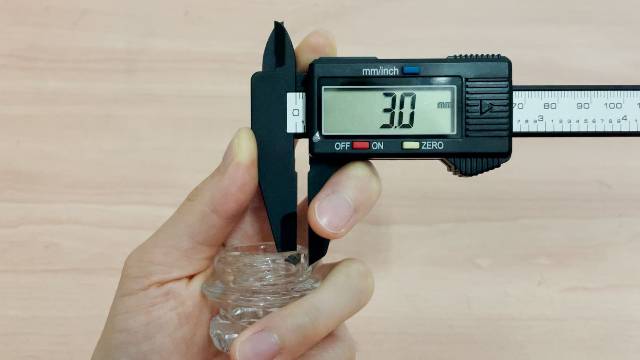
For perk knobs, especially glass ones, I recommend not screwing it in too tightly, so that it has space to expand when hot.
Finish of Materials
For the finish of the materials, my Bialetti and Primula Aluminum Percolators had a fair amount of staining, while my Coletti Percolator had slight staining. The rest were fine.
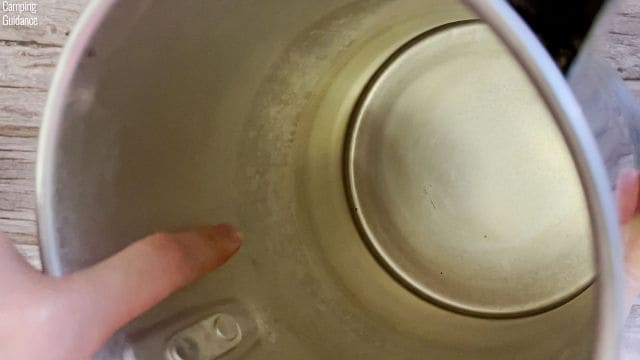
Quality Ratings
Based on everything above, here’s how I rated each camping percolator’s quality (out of 10, with 10 being the highest quality:
| Percolator | Quality Rating |
|---|---|
| Coletti Bozeman | 9.9 |
| GSI Outdoors Glacier | 9.4 |
| Coleman Percolator | 8.2 |
| Farberware Yosemite | 7.6 |
| Stanley Camp | 7.3 |
| Bialetti Moka Express | 7.3 |
| GSI Enamel Percolator | 5.5 |
| Stansport Percolator | 4.4 |
| Primula Percolator | 4.4 |
The Coletti and GSI Outdoors Stainless Steel Percolators are the highest quality, while the GSI Outdoors Enamel, Stansport Enamel and Primula Percolators were lower quality.
Taste
I conducted a blind taste test with 4 people to see whether the taste of the coffee changes with different percolators and different materials.
As far as I can tell, the stainless-steel percolators made slightly better tasting coffee than the enamel ones, and the enamel percolated coffee tasted slightly better than aluminum percolated coffee.
Also, the material of the perk knob, whether glass or plastic, did not really change the taste of the coffee.
But, of course, since this is entirely subjective, I will not be rating the percolators on taste.
Overall Performance
Based on all 5 tests that I rated above (brew time, capacity, ease of use, ease of clean up and quality) and the scoring in each test, here’s all the scores of each camping percolator side by side for easier comparison:

I color-coded the ratings to make it easier to look at. Green is for good, and yellow is for not so good. The overall performance scores are in the last column. I got to these scores by using this weightage:
- Brew Time: 10%
- Caapacity: 20%
- Ease of Use: 30%
- Clean Up: 10%
- Quality: 30%
In case you just want the overall scores without the individual tests, here you go:
| Percolator | Overall |
|---|---|
| Coletti Bozeman | 8.9 |
| GSI Outdoors Glacier | 8.6 |
| Farberware Yosemite | 8.4 |
| Stanley Camp Percolator | 8.2 |
| Coleman Percolator | 8.1 |
| Bialetti Moka Express | 7.7 |
| Primula Percolator | 6.9 |
| GSI Enamel Percolator | 6.7 |
| Stansport Percolator | 5.7 |
My 5 stainless steel camping percolators did better than my aluminum and enamel ones, with the Coletti Bozeman Percolator coming in first, and the GSI Outdoors Glacier Percolator a close second.
If you’d like to know how to choose the best camping percolator for yourself, check out this post here.
Or, if you’d like a guide on how to use a camping percolator to brew coffee outdoors, check out this helpful post here.
Frequently Asked Questions (FAQs)
Why You Should Trust Us
I spent almost $300 buying, and 4 months testing and reviewing the 9 best camping percolators in this review. I don’t accept free products from manufacturers, and don’t accept sponsored posts or YouTube videos. Each and every product is bought by me with my savings, and all opinions are my own, from months of real-world testing and usage.
Over 4 months, I brewed coffee in these camping percolators every single day, both outdoors and indoors, on portable stoves and home stoves, brewed 1 cup at a time to 12 cups at a time (subject to the maximum capacity of each percolator), amongst other things.
I looked at and examined every important aspect of each camping percolator, including but not limited to brew time, capacity, ease of use, ease of clean up, portability, quality, and taste. I also cover all features, specifications and even unboxings. Hopefully this comprehensive review has helped you to find the best camping percolator that suits your needs.
Conclusion
Ultimately, of all the 9 best camping percolators that I bought and tested, I think there’s one that will best suit your needs, and here’s quick summary of all of them:
Top Picks:
- Coletti Bozeman Percolator: Best Overall
- GSI Outdoors Glacier Percolator: Runner Up + Most Portable
- Farberware Classic Yosemite Percolator: Best Budget Pick
- Bialetti Moka Express: Easiest to Use
The Others:
- Stanley Camp Percolator: A good quality percolator if you’re a Stanley fan.
- Coleman Stainless Steel Percolator: Good quality, but not user-friendly and no replacement knobs.
- Primula Aluminum Percolator: Not recommended.
- Stansport Enamel Percolator: Not recommended.
- GSI Outdoors Enamelware Percolator: Not recommended.

